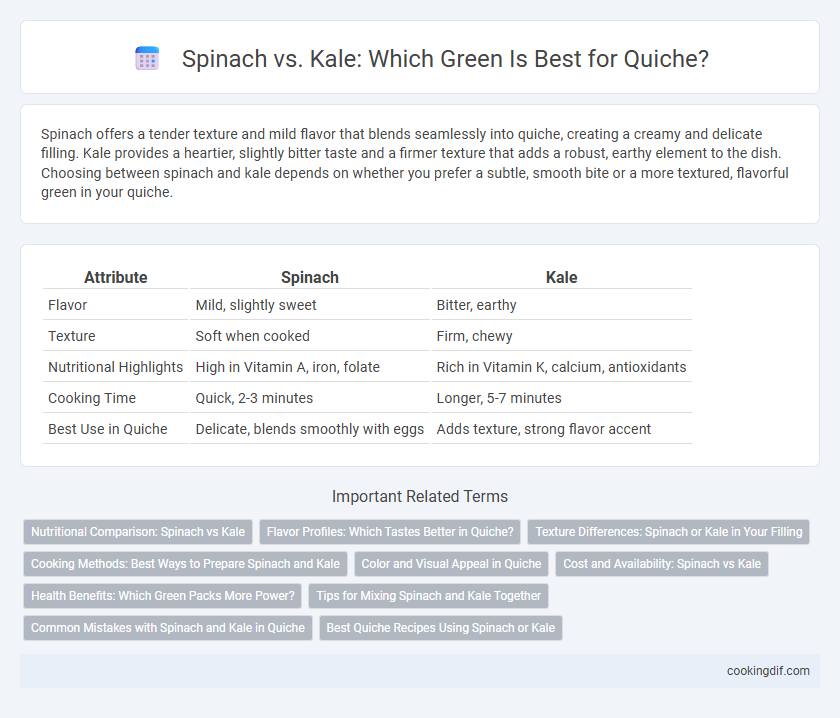Spinach offers a tender texture and mild flavor that blends seamlessly into quiche, creating a creamy and delicate filling. Kale provides a heartier, slightly bitter taste and a firmer texture that adds a robust, earthy element to the dish. Choosing between spinach and kale depends on whether you prefer a subtle, smooth bite or a more textured, flavorful green in your quiche.
Table of Comparison
| Attribute | Spinach | Kale |
|---|---|---|
| Flavor | Mild, slightly sweet | Bitter, earthy |
| Texture | Soft when cooked | Firm, chewy |
| Nutritional Highlights | High in Vitamin A, iron, folate | Rich in Vitamin K, calcium, antioxidants |
| Cooking Time | Quick, 2-3 minutes | Longer, 5-7 minutes |
| Best Use in Quiche | Delicate, blends smoothly with eggs | Adds texture, strong flavor accent |
Nutritional Comparison: Spinach vs Kale
Spinach and kale are both nutrient-dense greens commonly used in quiche, but they differ in their nutritional profiles. Spinach offers higher amounts of folate and magnesium, essential for cellular function and muscle health, while kale provides significantly more vitamin K and vitamin C, supporting bone health and immune function. Both greens supply antioxidants, fiber, and iron, making them excellent choices for a nutritious quiche filling.
Flavor Profiles: Which Tastes Better in Quiche?
Spinach offers a mild, slightly sweet flavor that complements the creamy texture of quiche without overpowering other ingredients, making it a popular choice for a balanced taste. Kale provides a more robust, earthy, and slightly bitter profile that adds depth and richness but can dominate the overall flavor if not balanced with enough cheese or seasoning. For quiche enthusiasts seeking a subtle and tender green, spinach is preferred, while those who enjoy a heartier, more pronounced green flavor often favor kale.
Texture Differences: Spinach or Kale in Your Filling
Spinach offers a tender, delicate texture that softens quickly when cooked, making it ideal for a smooth, cohesive quiche filling. Kale provides a chewier, heartier bite with a slightly fibrous structure that holds up well to baking, adding a satisfying contrast in texture. Choosing between spinach and kale depends on whether you prefer a silky or robust mouthfeel in your quiche.
Cooking Methods: Best Ways to Prepare Spinach and Kale
Sauteing spinach quickly in olive oil preserves its tender texture and vibrant color, while steaming kale softens its fibrous leaves without causing nutrient loss. Blanching both greens before adding them to the quiche reduces bitterness and prevents excess moisture from compromising the crust. Massaging kale with a bit of oil before cooking breaks down tough fibers, resulting in a milder flavor and improved mouthfeel in the final dish.
Color and Visual Appeal in Quiche
Spinach offers a vibrant, deep green color that brightens the quiche's appearance and creates an inviting, fresh look. Kale provides a darker, more rustic hue with a slightly curly texture that adds visual depth and contrast to the dish. Choosing spinach highlights a lighter, more delicate aesthetic, while kale enhances the quiche with rich, bold greens that stand out on the golden crust.
Cost and Availability: Spinach vs Kale
Spinach generally costs more than kale due to higher demand and shorter shelf life, making it a pricier choice for quiche greens. Kale tends to be more widely available year-round, often found in both fresh and frozen forms at lower prices. Choosing kale can be more budget-friendly and convenient for quiche recipes without compromising nutritional value.
Health Benefits: Which Green Packs More Power?
Spinach offers a higher content of iron and folate, essential for blood health and cellular function, while kale excels in vitamin K and antioxidants that support bone strength and reduce inflammation. Spinach contains more magnesium and vitamin A, promoting eye health and muscle function, whereas kale's dense fiber and vitamin C content enhance digestion and immune defense. Choosing between spinach and kale depends on specific nutritional needs, but kale generally provides a broader spectrum of antioxidants and vitamins for overall health.
Tips for Mixing Spinach and Kale Together
Combining spinach and kale in quiche creates a balanced flavor profile, as spinach offers a tender texture while kale provides a slightly bitter, hearty bite. To maximize moisture control, saute kale separately to soften its robust leaves, then briefly wilt spinach before mixing both greens together. This approach prevents sogginess and ensures an even distribution of nutrients and vibrant color in the quiche filling.
Common Mistakes with Spinach and Kale in Quiche
Using fresh spinach in quiche often results in excess moisture, causing a soggy crust if not properly drained and cooked beforehand. Kale requires thorough de-stemming and sauteing to reduce its toughness and bitterness, which many overlook, leading to an unpleasant texture and flavor. Overloading either green can overpower the delicate balance of eggs and cheese, diminishing the signature creamy consistency of a well-made quiche.
Best Quiche Recipes Using Spinach or Kale
Spinach and kale are the top greens for quiche, each bringing unique flavors and textures to the dish. Spinach provides a tender, mild taste that blends seamlessly with creamy custard, while kale offers a heartier, slightly bitter flavor that stands out in savory fillings. Recipes incorporating fresh spinach yield a delicate, moist quiche, whereas those using kale benefit from its robust structure, especially when pre-cooked to soften the leaves and reduce bitterness.
spinach vs kale for greens Infographic

 cookingdif.com
cookingdif.com